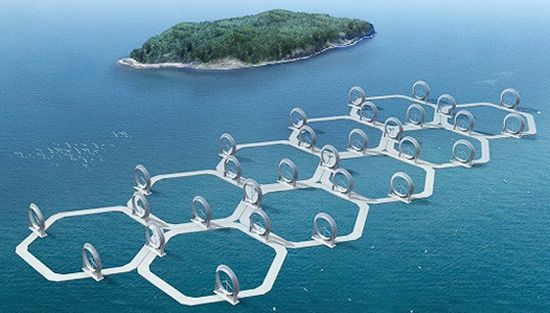
As we know it
With fossil fuel reserves depleting fast, researchers over the globe are focusing their attention on systems that can generate energy from renewable sources of energy such as wind. The trend is catching up fast as in 2005 wind energy generated less than one percent of global energy by producing 58,982MW of power. However, by 2008 eight percent of Europe’s electricity was derived from wind, which was well ahead of coal and natural gas. Moreover, wind power generation in the United States has increased 13 fold from what it was in 2000, and this surge has played a crucial role in propelling the U.S. to the number one position in terms of wind energy production.
According to statistics, about 2 percent of global electricity production comes from wind-powered generators, with capacity increasing manifold in recent years. The cost per watt of wind generated electricity is also less than solar energy in some countries.
Need for a change
Though wind energy does seem perfect for a green future, conventional wind turbines still face certain drawbacks. Wind turbines are expensive and can get damaged when hit by a heavy storm or severe lightning. Moreover, conventional horizontal axis wind turbines are criticized for not being bird-friendly. There is no dearth of people who believe that wind turbines look ugly on the landscape. Wind turbines, on an average make a sound of about 50-60 decibels, which annoys people living near wind farms.
What’s next
1. Flying Electric Generator
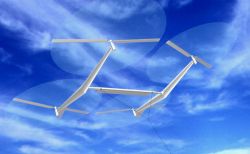
• What’s new:
Developed by San Diego-based Sky WindPower, this kite-like 1100lbs structure is capable of producing power for as little as 2 cents per kilowatt hour, while flying at an altitude of up to 30,000 feet. Four rotors at the points of an H-shaped frame provide the necessary lift to keep the platform floating in the air like a kite. Electricity generated by the spinning rotors is transmitted to the ground through aluminum cables tethered to the frame.
• What difference will it make:
The generators will be floating at altitudes where most birds don’t fly. Moreover, some researchers opine that harvesting 1 percent of energy from jet-stream winds could produce enough power for everybody on the planet.
• Problems:
Though the generators are bird-friendly and won’t bother anybody with noise, they will cost much more than conventional wind turbines. Moreover, being heavy, the design also faces stability issues.
2. Magenn Air Rotor System (MARS)
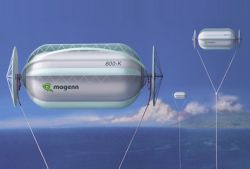
• What’s new:
Developed by Magenn Power, the MARS is a lighter-than-air tethered wind turbine that rotates about a horizontal axis in response to wind, generating electrical energy. Electricity generated by the system is transferred down the 1000-foot tether for immediate use, or to a set of batteries for later use, or to the power grid. Helium sustains MARS in air and allows it to ascend to a higher altitude than traditional wind turbines.
• What difference will it make:
The Magenn Air Rotor System is less expensive per unit of actual electrical energy output than competing wind power systems. Moreover, wind farms involving MARS can be placed closer to demand centers, reducing transmission line costs and transmission losses. The generators are also mobile and can easily moved to different locations to correspond to changing wind patterns.
• Problems:
The system does promise to generate renewable energy in an efficient manner. However, since the MARS floats in mid air, it is only suitable for relatively remote locations due to air rights and flight paths.
3) Wind Lens Turbines
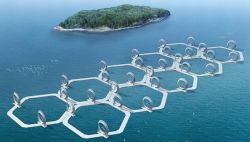
• What’s new:
Developed by Kyushu University Professor Yuji Ohya, the Wind Lens was unveiled at the Yokohama Renewable Energy International Exhibition 2010. The system features a honeycomb-like structure that triples the amount of wind energy that can be produced by offshore turbines. The Wind Lens works similar to a magnifying glass that intensifies light from the sun, except in this case, the lens is used to intensify wind flow.
• What difference will it make:
Each lens, which measures about 112m in diameter, will be able to provide enough energy for an average household. Moreover, since the system features unique hexagonal bases, it might also win over the many critics of wind turbines who claim that conventional turbines are an ugly blight on the landscape.
• Problems:
Though the system promises to deliver renewable energy at a reduced cost, it may not be easily adopted by countries other than Japan, due to differing intensities and directions of wind conditions.
4) The Aerogenerator
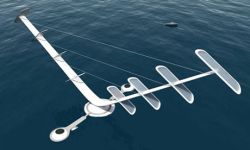
• What’s new:
Developed by Scottish firm called WindPower, the Aerogenerator resembles a giant rotary washing line. The 144-meter high V-shaped structure would be mounted on offshore locations to generate power through a rotating vertical shaft as opposed to the horizontal shafts of the more familiar windmill designs.
• What difference will it make:
The creators of the Aerogenerator claim that it can not only generate as much as 9MW of renewable electric power, but is also capable of harnessing wind from all directions without need for the usual gearing mechanisms needed in regular horizontal axis wind turbines. The developers also claim that the design overcomes the issues associated with large horizontal axis wind turbines.
• Problems:
The weight of the turbine blades could becomes excessive and when they turn they’ll be under enormous stress because gravity compresses them as they rise and stretches them as they fall. The larger the turbine is made the more robust the blades need to be, which will add to the cost of the turbine.
5) Vibro-Wind Setup
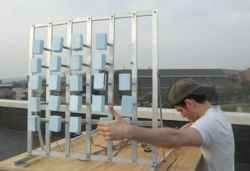
• What’s new:
Researchers at Vibro-Wind Research Group have developed a low-cost method of converting vibrations from wind energy to electricity. Similar to solar panels, which grace many rooftops today, the developers hope that soon buildings outfitted with Vibro-Wind panels stores the energy they convert even from the gentlest of breezes.
• What difference will it make:
While traditional wind energy harvesting systems require the use of large, expensive turbines, the Vibro-Wind Setup would require a fraction of the space and cost much less. Moreover, the setup generates electricity from vibration caused by wind rather than wind itself, which increases the efficiency of the setup.
• Problems:
The developing team is currently working on the integration of these energy-harvesting panels into buildings. Once the issues related with installation are sorted out, it will be nice to see how much energy the setup can generate.




